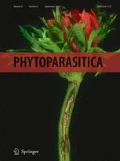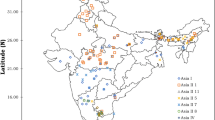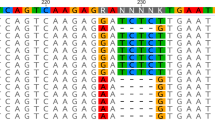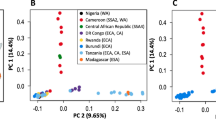Abstract
Among the Bemisia tabaci (Hemiptera: Aleyrodidae) species complex, the Middle East–Asia Minor I (MEAMI) and the Mediterranean (Med) species are the most invasive and widespread agricultural pests worldwide. Currently, only Tunisia and a few other countries are reported to still “host” these two competing species. The objective was thus to improve our knowledge on the factors, particularly the host plant, which contribute to this unusual situation. To that end, we analyzed 47 samples collected from protected and outdoor plants (ten vegetables and ornamentals) in the two main crop-producing regions of Tunisia to (i) better document the co-occurrence of several B. tabaci species and populations, and (ii) confirm the role of the host plant in the distribution pattern of each species. B. tabaci specimens were identified using at least two molecular diagnostic tests. Taken together, the tests confirmed the equivalent prevalence of Med and MEAMI species and, for the first time, the presence of some Sub-Saharan Africa 2 B. tabaci, in Tunisia. The regional co-occurrence between Med and MEAM1 was based on spatial and host-plant partitioning. Our results indicate that Med species are closely associated with ornamentals and MEAM1 with vegetables. Med displayed a higher level of genetic diversity than MEAM1, and another Med specimen characterized by a mtCOI haplotype which perfectly matched the ancestral Gennadius specimen was discovered. The role of host plant type and possible associated factors in the distribution patterns of MEAM1 and Med is discussed in the context of the co-occurrence of cryptic species.



Similar content being viewed by others
References
Abrahamson, W. G., & Blair, C. P. (2008). Sequential radiation though host-race formation: herbivore diversity leads to diversity in natural enemies. In K. J. Tilmon (Ed.), The evolutionary biology of herbivorous insects. Specialization, speciation, and radiation (pp. 188–202). Berkeley, CA, USA: University of California Press.
Adkins, A., Webb, S. E., Roberts, P. D., Kousik, C. S., Stansly, P. A., Bruton, B. D., et al. (2010). A review of Ipomovirus and watermelon vine decline in Florida. In P. A. Stansly & S. E. Naranjo (Eds.), Bemisia: Bionomics and management of a global pest (pp. 333–337). Dordrecht: Springer.
Amarasekare, P., Hoopes, M. F., Mouquet, N., & Holyoak, M. (2004). Mechanisms of coexistence in competitive metacommunities. The American Naturalist, 164, 310–326.
Bickford, D., Lohman, D. J., Sodhi, N. S., Mefer, P. K. L., Winker, K., Ingram, K. K., et al. (2006). Cryptic species as a window on diversity and conservation. Trends in Ecology and Evolution, 22, 148–155.
Bielza, P., Gauthier, N., Gilioli, G., et al. (2013). Scientific opinion on the risks to plant health posed by Bemisia tabaci species complex and viruses it transmits for the EU territory. EFSA Journal, 2013(11), 3162.
Bonato, O., Lurette, A., Vidal, C., & Fargues, J. (2007). Modelling temperature-dependent bionomics of Bemisia tabaci (Q- biotype). Physiological Entomology, 32, 50–55.
Bosco, D., Loria, A., Sartor, C., & Cenis, J. L. (2006). PCR-RFLP identification of Bemisia tabaci biotypes in the Mediterranean Basin. Phytoparasitica, 34, 243–251.
Castle, S. J., Palumbo, J. C., Prabhaker, N., Horowitz, A. R., & Denholm, I. (2010). Ecological determinants of Bemisia tabaci resistance to insecticides. In P. A. Stansly & S. E. Naranjo (Eds.), Bemisia: Bionomics and management of a global pest (pp. 423–465). Dordrecht, the Netherlands: Springer.
Chesson, P. (2000). Mechanisms of maintenance of species diversity. Annual Review of Ecology, Evolution, and Systematics, 31, 343–366.
Chu, D., Wan, F. H., Zhang, Y. J., & Brown, J. K. (2010a). Change in the biotype composition of Bemisia tabaci in Shandong Province of China from 2005 to 2008. Environmental Entomology, 39, 1028–1036.
Chu, D., Zhang, Y. J., Brown, J. K., Cong, B., Xu, B. Y., Wu, Q. J., et al. (2006). The introduction of the exotic Q biotype of Bemisia tabaci from the Mediterranean region into China on ornamental crops. Florida Entomologist, 89, 168–174.
Chu, D., Zhang, Y. J., & Wan, F. H. (2010b). Cryptic invasion of the exotic Bemisia tabaci biotype Q occurred widespread in Shandong Province of China. Florida Entomologist, 93, 203–207.
Craig, T. P., & Itami, J. K. (2008). Evolution of preference and performance relationships. In K. J. Tilmon (Ed.), The evolutionary biology of herbivorous insects. Specialization, speciation, and radiation (pp. 20–28). Berkeley, CA, USA: University of California Press.
Crowder, D. W., Horowitz, A. R., De Barro, P. J., Liu, S. S., Showalter, A. M., Kontsedalov, S., et al. (2010a). Mating behaviour, life history and adaptation to insecticides determine species exclusion between whiteflies. Journal of Animal Ecology, 79, 563–570.
Crowder, D. W., Sitvarin, M. I., & Carrière, Y. (2010b). Plasticity in mating behaviour drives asymmetric reproductive interference in whiteflies. Animal Behaviour, 79, 579–587.
Cuthbertson, A. G. S., Blackburn, L. F., Eyre, D. P., Cannon, R. J. C., Miller, J., & Northing, P. (2011). Bemisia tabaci: The current situation in the UK and the prospect of developing strategies for eradication using entomopathogens. Insect Science, 18, 1–10.
Dalmon, A., Halkett, F., Granier, M., Delatte, H., & Peterschmitt, M. (2008). Genetic structure of the invasive pest Bemisia tabaci: evidence of limited but persistent genetic differentiation in glasshouse populations. Heredity, 100, 316–325.
De Barro, P. J., Bourne, A., Khan, S. A., & Brancatini, V. A. L. (2006). Host plant and biotype density interactions - their role in the establishment of the invasive B biotype of Bemisia tabaci. Biological Invasions, 8, 287–294.
De Barro, P. J., Liu, S. S., Boykin, L. M., & Dinsdale, A. B. (2011). Bemisia tabaci: a statement of species status. Annual Review of Entomology, 56, 1–19.
Delatte, H., Duyck, P. F., Triboire, A., David, P., Becker, N., Bonato, O., et al. (2009). Differential invasion success among biotypes: case of Bemisia tabaci. Biological Invasions, 11, 1059–1070.
Delatte, H., Reynaud, B., Granier, M., Thornary, L., Lett, J. M., Goldbach, R., et al. (2005). A new silverleaf-inducing biotype Ms of Bemisia tabaci (Hemiptera: Aleyrodidae) indigenous to the islands of the south-west Indian Ocean. Bulletin of Entomological Research, 95, 29–35.
De la Rúa, P., Simon, B., Cifuentes, D., Martinez-Mora, C., & Cenis, J. L. (2006). New insights into the mitochondrial phylogeny of the whitefly Bemisia tabaci (Hemiptera: Aleyrodidae) in the Mediterranean basin. Journal of Zoological Systematics and Evolutionary Research, 44, 25–33.
Dennehy, T. J., Degain, B. A., Harpold, V. S., Zaborac, M., Morin, S., Fabrick, J. A., et al. (2010). Extraordinary resistance to insecticides reveals exotic Q biotype of Bemisia tabaci in the New World. Journal of Economic Entomology, 103, 2174–2186.
Elbaz, M., Lahav, N., & Morin, S. (2010). Evidence for pre-zygotic reproductive barrier between the B and Q biotypes of Bemisia tabaci (Hemiptera: Aleyrodidae). Bulletin of Entomological Research, 100, 581–590.
Elbaz, M., Weiser, M., & Morin, S. (2011). Asymmetry in thermal tolerance trade offs between the B and Q sibling species of Bemisia tabaci (Hemiptera, Aleyrodidae). Journal of Evolutionary Biology, 24, 1099–1109.
Erdogan, C., Moores, G. D., Oktay Gurkan, M., Gorman, K. J., & Denholm, I. (2008). Insecticide resistance and biotype status of populations of the tobacco whitefly Bemisia tabaci (Hemiptera, Aleyrodidae) from Turkey. Crop Protection, 27, 600–605.
Friberg, M., & Wicklund, C. (2009). Host plant preference and performance of the sibling species of butterflies Leptidea sinapis and Leptidea reali: a test of the trade-off hypothesis for food specialisation. Oecologia, 159, 127–137.
Gauthier, N., Clouet, C., Perrakis, A., Kapantaidaki, D., Peterschmitt, M., & Tsagkarakou, A. (2014). Genetic structure of Bemisia tabaci Med populations from home range countries inferred by nuclear and cytoplasmic markers: impact on the distribution of the insecticide resistance genes. Pest Management Science, 70, 1477–1491.
Gerling, D., & Mayer, R. T. (1996). Bemisia 1995: taxonomy, biology, damage, control and management. Andover, UK: Intercept.
Gilbert, B., Srivastava, D. S., & Kirby, K. R. (2008). Niche partitioning at multiple scales facilitates coexistence among mosquito larvae. Oikos, 117, 944–950.
Gripenferg, S., Mayhew, P. J., Parnell, M., & Roslin, T. (2010). A meta-analysis of preference-performance relationships in phytophagous insects. Ecology Letters, 13, 383–393.
Guindon, S., Dufayard, J. F., Lefort, V., Anisimova, M., Hordijk, W., & Gascuel, O. (2010). New algorithms and methods to estimate maximum-likelihood phylogenies: assessing the performance of PhyML 3.0. Systematic Biology, 59, 307–321.
Hardin, G. (1960). Competitive exclusion principle. Science, 131, 1292–1297.
Horowitz, A. R., Kontsedalov, S., Khasdan, V., & Ishaaya, I. (2005). Biotypes B and Q of Bemisia tabaci and their relevance to neonicotinoid and pyriproxyfen resistance. Archives of Insect Biochemistry and Physiology, 58, 216–225.
Hu, J., De Barro, P., Zhao, H., Wang, J., Nardi, F., & Liu, S. S. (2011). An extensive field survey combined with a phylogenetic analysis reveals rapid and widespread invasion of two alien whiteflies in China. PLoS ONE, 6, e16061.
Iida, H., Kitamura, T., & Honda, K. (2009). Comparison of egg hatching rate, survival rate and development time of the immature stage between B and Q biotypes of Bemisia tabaci (Gennadius) (Homoptera, Aleyrodidae) on various agricultural crops. Applied Entomology and Zoology, 44, 267–273.
Khasdan, V., Levin, I., Rosner, A., Morin, S., Kontsedalov, S., Maslenin, et al. (2005). DNA markers for identifying biotypes B and Q of Bemisia tabaci (Hemiptera: Aleyrodidae) and studying population dynamics. Bulletin of Entomological Research, 95, 605–613.
Kontsedalov, S., Abu-Moch, F., Lebedev, G., Czosnek, H., Horowitz, A. R., & Ghanim, M. (2012). Bemisia tabaci biotype dynamics and resistance to insecticides in Israel during the years 2008-2010. Journal of Integrative Agriculture, 11, 312–320.
Legg, J. P., French, R., Rogan, D., Okao-Okuja, G., & Brown, J. K. (2002). A distinct Bemisia tabaci (Gennadius) (Hemiptera: Sternorryncha: Aleyrodidae) genotype cluster is associated with the epidemic of severe cassava mosaic virus disease in Uganda. Molecular Ecology, 11, 1219–1229.
Liu, S. S., De Barro, P., Xu, J., Luan, J. B., Zang, L. S., Ruan, Y. M., et al. (2007). Asymmetric mating interactions drive widespread invasion and displacement in a whitefly. Science, 318, 1769–1772.
Maruthi, M. N., Colvin, J., Thwaites, R. M., Banks, G. K., Gibson, G., & Seal, S. E. (2004). Reproductive incompatibility and COI sequence variability amongst host-adapted and geographically separate Bemisia tabaci populations (Hemiptera: Aleyrodidae). Systematic Entomology, 29, 560–568.
McKenzie, C. L., Bethke, J. A., Byrne, F. J., Chamberlin, J. R., Dennehy, T. J., Dickey, A. M., et al. (2012). Distribution of Bemisia tabaci (Hemiptera, Aleyrodidae) biotypes in North America after the Q invasion. Journal of Economic Entomology, 105, 753–766.
Moya, A., Guirao, P., Cifuentes, D., Beitia, F., & Cenis, J. (2001). Genetic diversity of Iberian populations of Bemisia tabaci (Hemiptera, Aleyrodidae) based on random amplified polymorphic DNA polymerase chain reaction. Molecular Ecology, 10, 891–897.
Muñiz, M., & Nombela, G. (2001). Differential variation in development of the B and Q biotypes of Bemisia tabaci (Homoptera, Aleyrodidae) on sweet pepper at constant temperatures. Environmental Entomology, 30, 720–727.
Naranjo, S. E., Castle, S. J., De Barro, P. J., & Liu, S. S. (2010). Population dynamics, demography, dispersal and spread of Bemisia tabaci. In P. A. Stansly & S. E. Naranjo (Eds.), Bemisia: Bionomics and management of a global pest. Dordrecht (pp. 185–226). the Netherlands: Springer.
Neill, C., Daufresne, T., & Jones, C. G. (2009). A competitive coexistence principle? Oikos, 118, 1570–1578.
Nombela, G., Beitia, F., & Muñiz, M. (2001). A differential interaction study of Bemisia tabaci Q-biotype on commercial tomato varieties with or without the Mi resistance gene, and comparative host response with the B-biotype. Entomologia Experimentalis et Applicata, 98, 339–344.
Oliveira, M., Henneberry, T., & Anderson, P. (2001). History, current status and collaborative research projects for Bemisia tabaci. Crop Protection, 20, 709–723.
Papayiannis, L. C., Brown, J. K., Seraphides, N. A., Hadjistylli, M., Ioannou, N., & Katis, N. I. (2009). A real-time PCR assay to differentiate the B and Q biotypes of the Bemisia tabaci complex in Cyprus. Bulletin of Entomological Research, 99, 573–582.
Parrella, G., Scassillo, L., & Giorgini, M. (2012). Evidence for a new genetic variant in the Bemisia tabaci species complex and the prevalence of the biotype Q in southern Italy. Journal of Pest Science, 85, 227–238.
Pascual, S., & Callejas, C. (2004). Intra- and interspecific competition between biotypes B and Q of Bemisia tabaci (Hemiptera: Aleyrodidae) from Spain. Bulletin of Entomological Research, 94, 369–375.
Posada, D. (2008). jModelTest: Phylogenetic model averaging. Molecular Biology and Evolution, 25, 1253–1256.
Rao, Q., Luo, C., Zhang, H., Guo, X., & Devine, G. (2011). Distribution and dynamics of Bemisia tabaci invasive biotypes in central China. Bulletin of Entomological Research, 101, 81–88.
Reitz, S., & Trumble, J. T. (2002). Competitive displacement among insects and arachnids. Annual Review of Entomology, 47, 435–465.
Rozas, J., Sanchez-Delbarrio, J. C., Messeguer, X., & Rozas, R. (2003). DnaSP, DNA polymorphism analyses by the coalescent and other methods. Bioinformatics, 19, 2496–2497.
Saleh, D., Laarif, A., Clouet, C., & Gauthier, N. (2012). Spatial and host-plant partitioning between coexisting Bemisia tabaci cryptic species in Tunisia. Population Ecology, 54, 261–274.
Siepielski, A. M., & McPeek, M. A. (2010). On the evidence for species coexistence: a critique of the coexistence program. Ecology, 91, 3153–3164.
Simón, B., Cenis, J., & De la Rúa, P. (2007). Distribution patterns of the Q and B biotypes of Bemisia tabaci in the Mediterranean Basin based on microsatellite variation. Entomologia Experimentalis et Applicata, 124, 327–336.
Sun, D. B., Liu, Y. Q., Xu, J., Li, F. F., & Liu, S. S. (2013). Competitive displacement between two invasive whiteflies: insecticide application and host plant effects. Bulletin of Entomological Research, 103, 344–353.
Sun, D. B., Xu, J., Luan, J. B., & Liu, S. S. (2011). Reproductive incompatibility between the B and Q biotypes of the whitefly Bemisia tabaci in China: genetic and behavioural evidence. Bulletin of Entomological Research, 101, 211–220.
Swofford, D. L. (2002). PAUP*: Phylogenetic analysis using parsimony (* and other methods). Sunderland, MA, USA: Sinauer Associates, Inc.
Tahiri, A., Halkett, F., Granier, M., Gueguen, G., & Peterschmitt, M. (2013). Evidence of gene flow between sympatric populations of the Middle East-Asia Minor 1 and Mediterranean putative species of Bemisia tabaci. Ecology and Evolution, 3, 2619–2633.
Tay, W. T., Evans, G. A., Boykin, L. M., & De Barro, P. J. (2012). Will the real Bemisia tabaci please stand up? PLoS ONE, 7, e50550.
Teng, X., Wan, F. H., & Chu, D. (2010). Bemisia tabaci biotype Q dominates other biotypes across China. Florida Entomologist, 93, 363–368.
Tsagkarakou, A., Mouton, L., Kristoffersen, J., Dokianakis, E., Grispou, M., & Bourtzis, K. (2012). Population genetic structure and secondary endosymbionts of Q Bemisia tabaci (Hemiptera, Aleyrodidae) from Greece. Bulletin of Entomological Research, 102, 353–365.
Tsagkarakou, A., Tsigenopoulos, K., Gorman, K., Lagnel, J., & Bedford, I. D. (2007). Biotype status and genetic polymorphism of the whitefly Bemisia tabaci (Hemiptera: Aleyrodidae) in Greece: mitochondrial DNA and microsatelllites. Bulletin of Entomological Research, 97, 29–40.
Tsueda, H., & Tsuchida, K. (2011). Reproductive differences between Q and B whiteflies, Bemisia tabaci, on three host plants and negative interactions in mixed cohorts. Entomologia Experimentalis et Applicata, 141, 197–207.
Xu, J., De Barro, P. J., & Liu, S. S. (2010). Reproductive incompatibility among genetic groups of Bemisia tabaci supports the proposition that the whitefly is a cryptic species complex. Bulletin of Entomological Research, 100, 359–360.
Zang, L. S., Chen, W. Q., & Liu, S. S. (2006). Comparison of performance on different host plants between the B biotype and a non-B biotype of Bemisia tabaci from Zhejiang, China. Entomologia Experimentalis et Applicata, 121, 221–227.
Acknowledgments
This study was funded mainly by the Institut de Recherche pour le Développement through a grant for the graduate student D. Saleh and some financial support for our associate researcher A. Laarif from the Tunisian Jeune Equipe Associée, and by a French National Research Agency Programme (BemisiaRisk project 06-PADD-04). Data used in this work were produced partly through the technical facilities of the Centre Méditerranéen Environnement Biodiversité in Montpellier, France.
Author information
Authors and Affiliations
Corresponding author
Rights and permissions
About this article
Cite this article
Laarif, A., Saleh, D., Clouet, C. et al. Regional co-occurrence between distinct Bemisia tabaci species in Tunisia with new insights into the role of host plants. Phytoparasitica 43, 135–150 (2015). https://doi.org/10.1007/s12600-014-0437-y
Received:
Accepted:
Published:
Issue Date:
DOI: https://doi.org/10.1007/s12600-014-0437-y




